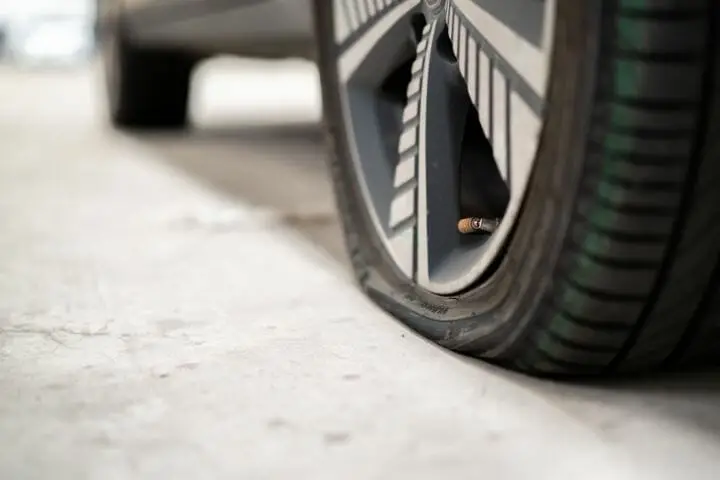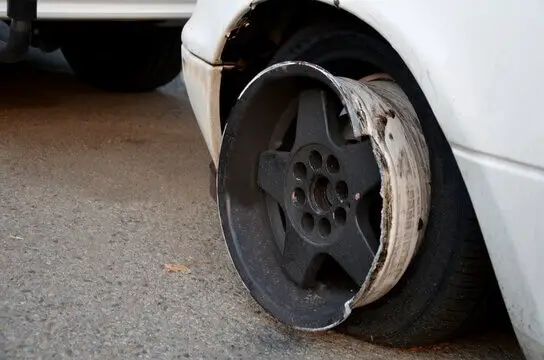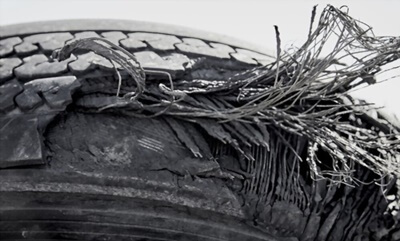First, park the vehicle in a suitable area to fix the rim cracks. Then, find the damage and determine its severity. Use a brush to clean the crack’s surroundings. Make an epoxy-hardener mixture and apply it on the cleaned surface. Once it has dried, attach the wheels to fix an air-leaky cracked rim.
Keep on reading to learn in detail about how to fix a cracked rim that leaks air in some 9 easy steps.
9 Easy Steps To Fix A Cracked Rim That Leaks Air

I have simplified the tactics to repair these rim cracks that leak air.
Step 01: Park The Car
Park the car when you feel the tire pressure is off, the steering is shaking, or it’s tough to handle the vehicle. It would be best to park it somewhere safe so that you can easily access the tire rims.
Remember to turn off the engine and put the parking brake on. Otherwise, the vehicle won’t be stable.
Step 02: Find The Crack
Now that you’ve parked your car, find the crack carefully. It’s elementary to find the damage if it’s on the rim’s surface. But you’ve to toil for some time to find the inferior cracks on the edge.

Step 03: Crack Inspection
After finding and cleaning the crack, determine the seriousness of the damage. To do this, inflate the tire while listening for a hissing sound or search for bubbles while the tire is submerged in water.
Also, try to find the crack angle. This helps to fix the crack quickly.
Step 04: Crack Cleaning
Clean the cracked area with a brush after you’ve found it. You can use a brush to clean dirt and debris. You should use high-pressure water to remove the paint. It’ll do the cleaning and clearing at the same time.
Cleaning an extra 2 to 3 inches around the crack helps to detect the micro-cracks around it. Now take a rag and put alcohol on it. Use this rag to wipe out the water. Don’t forget to wipe the entire rim. Then leave it for drying.
Note: Don’t miss the cleaning part as it’ll help you to identify the crack better. Cleaning is necessary every time you apply any troubleshooting process. For example, you should clean the tires before resetting the tire pressure in a 2018 Honda CRV.
Step 05: Make A Resin Mixture
While the alcohol is drying on the rim, make an epoxy resin and hardener mixture. Use high-quality, heat-resistant epoxy, like JB Weld etc.
First, take out the hardener tube and then the resin tube. Stir the mixture until you observe any color change. Don’t stop mixing after the mixture color has changed.
Step 06: Mixture Application
Before you apply the epoxy mixture to the rim cracks, use scrapers and slip under the mixture. Then put it on the crack.
You should apply force to attach the mixture properly to the damage. Remember to cover the extra 2 to 3 inches around the gap. As this will keep the resin on the rim surface longer, you’ll get better results.
Step 07: Surface Drying
Don’t try to drive your car instantly after putting the epoxy mixture on the rim cracks. It’ll worsen the condition. Instead, leave it at least for 10 to 12 hours for drying, or apply the epoxy mixture and leave it for a night. The combination will create a strong bond if you give it enough time to dry.
Step 08: Attaching The Rim To The Wheel
Attach the rim to the wheel after the surface has dried properly. You should follow the manual to connect the rim to your car’s wheel.
Step 09: Recheck
Perform a recheck after completing all the steps. The leak hasn’t been fully fixed if the rim still leaks air. In that case, it would be best to repair or even replace the cracked rim in the nearest repair shop.
How Much Does It Cost To Repair A Cracked Rim?
Repairing a cracked rim’s DIY cost varies from $20 for minor to $50-$400 for severe damage. Professional fixes range from $65 to $500 per wheel, averaging $130-$200.
Repair expenses depend on damage severity, and wheel type, with aluminum and chrome costing more than steel. Typically, fixing a cracked rim is labor-intensive, costing $200-$500 per wheel. Consider damage extent and wheel type when estimating repair costs.
Reasons Behind A Cracked Rim: Know All To Apply Fix
Check out the reasons behind the cracked rim of a wheel from the analysis below.
Flat Tire:
Driving with a flat tire increases rim cracking probability. A punctured tire fails to deliver the optimum performance and creates cracks in the tire rim. Don’t forget that sudden temperature change is responsible for a punctured tire. Since a tire blows out due to outside temperature and tire pressure, it’s highly likely to damage its rim.
Potholes:
Potholes are a red flag for alloy and aluminum rims. And aluminum crack repair cost is high. Deep and edgy pothole damage can severely damage the edge with additional car parts. As a result, small cracks can become huge holes if they get larger with time.
Curb Drive:
Curb driving is another prime reason behind a cracked rim. It depends on your driving habits. However, if the cub’s width and length don’t fit with the rims, it’s highly likely to damage the tire rim. The same happens if you park your car near a curb and drive recklessly while moving the vehicle.
Defective Wheels:

There’s a high probability your tire rims are cracking because of using bad-quality wheels. If you’re installing cheap wheels to save money, it’ll increase your cost and damage the wheel severely. The cracks become visible and sharp if not taken care of in time.
Signs Of A Cracked Rim: How To Identify?
Learn about these crucial signs a rim shows if it’s broken.
Shaking Of Steering: Your car’s steering will shake non-stop if the rim is defective. Sometimes you might hear various sounds and feel the vibration from the steering column simultaneously. Consequently, it becomes tough to control the car resulting in serious accidents.
Imbalanced Tire Pressure: If the rim edge is cracked, you’ll feel the tires aren’t balanced. So, when you drive, these tires will lose pressure affecting your vehicle’s mileage. It’s tough to fix the rim if the crack is inside and the tire loses pressure. In this case, you have to put more emphasis on fixing the tire valve stripped stem.
Poor Handling: You won’t be able to control your car properly if you’re driving with a cracked rim. First, your steering is shaking, and the tire pressure isn’t balanced, which leads you to this situation.
Taking turns while driving seems impossible while driving with a defective rim. The situation gets even worse if you want to take sharp turns.
Expert Tips To Fix A Cracked Rim: Do It Perfectly
If you are still looking for rim cracks and fixing them, following these tips will guide you to find an easy solution.
- Remember, you can DIY the cracks on the back and inside of the rim.
- Never wield cracks on the front of the rim. It can change the wheel structure.
- Contact a mechanic if you find cracks in the pin and lug area.
- You should change the rim if the cracks have a Y shape and parallel cracks. I would suggest getting the ALPHAequipt Command Bronze Wheels 17 In 17×8.5 wheel.
- Ask a mechanic to wield the aluminum rim cracks. Don’t try to weld it yourself since you aren’t a professional.
Frequently Asked Questions (FAQs):
What Rim Damage Can’t Be Repaired?
Rim damage that cannot be repaired includes severe bending or warping, cracks that penetrate the entire thickness of the rim, and damage that affects the structural integrity of the rim. In these cases, the rim will likely need to be replaced.
Is It Worth Welding A Cracked Rim?
It depends on the severity of the crack and the location of the crack on the rim. A small crack in a non-critical area of the rim may be able to be welded and still be safe for use. However, a large crack or one that is located in a critical area of the rim may not be safe to weld and the rim may need to be replaced.
How Long Do Rims Last?
Rims generally last about 10 years, but aggressive wear can shorten their lifespan. Regular inspections are advisable due to unpredictable wear and damage.
Final Words
Hopefully, the discourse on how to fix a cracked rim that leaks air has provided you with the required information. Remember to follow the pro tips if you face any difficulties. Regular maintenance will help you find minor rim cracks before they become critical.
